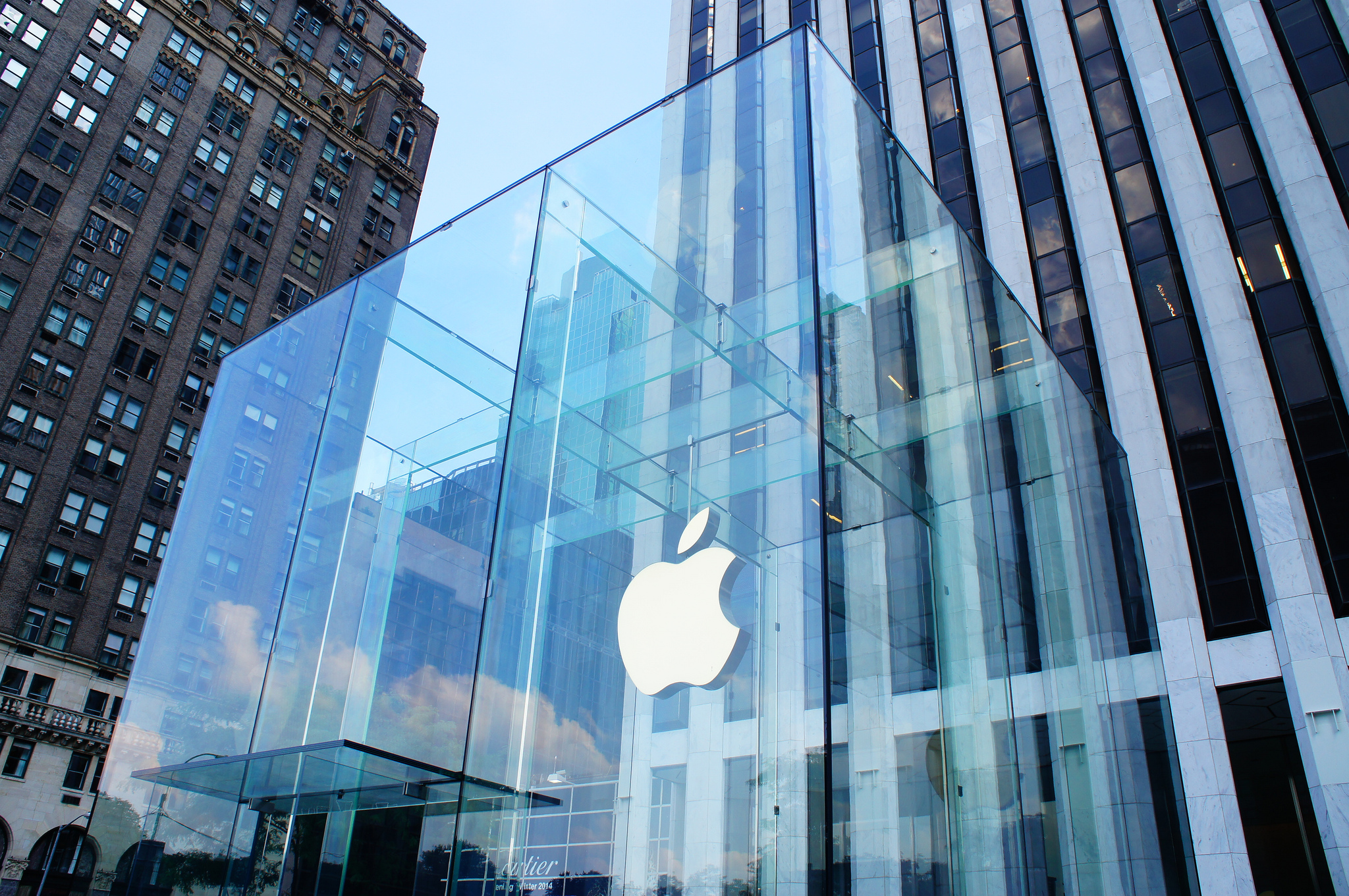Sign up for The Media Today, CJR’s daily newsletter.
Stung by changes to Facebook’s News Feed, publishers are reportedly “falling in love with Apple News”—though the affection may not always be mutual.
Unlike its rivals, Apple News employs human editors who curate news in addition to its algorithmic feed. When Apple first advertised for these positions, the company specified that the editors must “be able to recognize original, compelling stories unlikely to be identified by algorithms.”
But humans, like algorithms, are prone to habit, and Apple News may have fallen into a pattern that Facebook and others have been trying to avoid: editorial bias. A new Tow Center analysis of almost 7,000 recommendations made in newsletters and tweets by the US and UK arms of Apple News shows a strong tendency by editors to favor a small group of big players and less inclination to promote regionally focused news outlets—a class of publisher that New York Times Editor Dean Baquet put at the center of “the greatest crisis in journalism” in a speech at the Freedom of the Press Awards.
It is the Times itself that has dominated newsletter recommendations from Apple News’s US editors, while the Daily Telegraph is held up as the gold standard by their UK counterparts. On average, these outlets have received one of the five places in their country’s newsletters every other week. Across the 78 US newsletters reviewed by Tow, just 14 of the 390 articles recommended—under 4 percent—came from newsrooms that fit this study’s broad definition of a regionally focused publisher: eight from New York magazine, five from the Los Angeles Times, and one from The Baltimore Sun.
An interesting quirk in choices made by UK editors is the frequency with which the London Evening Standard gets promoted. Not only was the Evening Standard—a tabloid newspaper distributed for free in London—the only regional publisher found in newsletter recommendations (and 21 times at that), it also accounted for 82 out of 83 mentions of regional outlets in @AppleNewsUK tweets.
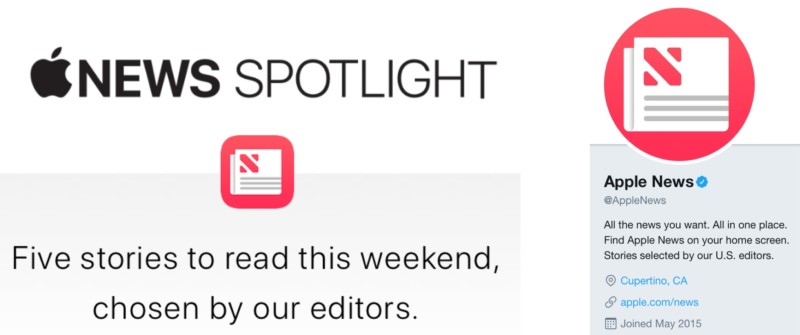
The role of human editorial highlighted in the Apple News Spotlight newsletter (left) and Twitter account bio.
A note on methodology: Tow’s analysis is based on 839 recommendations made in 165 weekly newsletters, and 6,029 mentions made in 6,731 tweets from Apple News’s US and UK accounts. Both Apple News US and UK newsletters and their respective Twitter accounts explicitly state that recommendations are editorial choices made by editors. 78 of the newsletters were published by Apple News US (dating back to October 22, 2016) and 87 by Apple News UK (dating back to July 30, 2016). The most recent newsletter in the sample was received on Saturday, May 5, 2018. Approximately three newsletters are missing from the US sample, while four are missing from the UK sample. The Twitter sample, gathered via CrowdTangle, consists of 3,998 tweets posted from the @AppleNews account between April 5, 2016 and May 4, 2018; and 2,773 posted from @AppleNewsUK (seemingly now dormant) between May 5, 2016 and January 28, 2018.
Collectively, our sample of 165 newsletters contained 839 recommendations. The 78 US newsletters contained a total of 390 recommendations—five per newsletter. Across these, 68 different news outlets were recommended. The 87 UK newsletters contained 449 recommendations. (The first seven, received July 30, 2016—September 3, 2016, contained seven recommendations. The subsequent 80 contained five.) The total number of different outlets promoted across these was 88.
Apple did not provide on-the-record comment to CJR.
The Apple Difference
Publishers’ attitudes towards Apple News have fluctuated considerably since its launch in September 2015. Following reports of a “rocky start,” the consensus seemed to be that Apple News was driving great traffic but wasn’t necessarily helping them make more money.
In June 2015, much was made of the initial news that Apple would be employing human editors for its then upcoming news service. Since then, the company has reportedly made moves to increase its news and editorial efforts. And apparently, publishers have responded positively to the human touch. As Facebook’s appeal to publishers has diminished, Apple News’s appears to have grown considerably—and, as announced yesterday, the app will extend to Mac laptops and desktops. Business Insider recently speculated that the reason “Apple News is suddenly a favorite among consumers and publishers” is that “it’s curated and less cluttered.”
READ: Nick Diakopoulos on reporting in a machine reality
So how, exactly, does Apple go about choosing which stories to highlight? Apple reportedly fields publishers’ pitches via email and a dedicated Slack channel in a manner that Digiday describes as “hands-on.” According to The Information:
“When news publishers have a big story these days, their editors jump on Slack and pitch it to an unlikely partner: Apple. […] From the pitch received via a dedicated Slack channel, Apple’s editorial team of about a dozen staffers in the US decides what story gets featured at the top of the app or to the left of the home screen.”
Certain publishers have apparently cultivated particularly close relationships with the Apple News team. Mic’s product head reportedly “has a standing weekly call with Apple News,” while another Digiday report said that “the amount of time product managers at [The Washington Post] talk to Apple amounts to about half one person’s time.”
For newsrooms fortunate enough to have the resources to facilitate such close relationships, there are numerous benefits. As Digiday describes it, “The Post and other publishers believe being all-in has… rewards. In addition to the tangible benefit of traffic, there’s access to executives and ability to influence their roadmap. And they’ve organized themselves accordingly.” According to the same report, the Post has “lobbied successfully for Apple’s editors to promote Post stories on the app.”
Apple editors really love The New York Times and the Daily Telegraph
In June 2015, when news first broke that Apple was seeking to hire editors for Apple News, 9to5Mac wrote, “Apple won’t just be curating stories from the big players. It [Apple’s job listing] also mentions a focus on surfacing original content from ‘the largest to the smallest’ publishers.”
Data from both newsletter and Twitter mentions suggests a strong preference for large publishers over small ones.
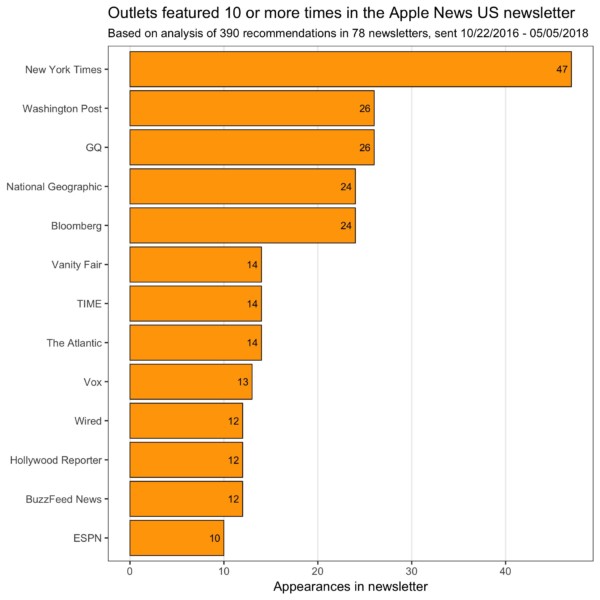
The New York Times is comfortably the most mentioned publisher in US Apple News newsletters, appearing 47 times—60 percent of all US newsletters. The other four publishers to be featured over twenty times were: GQ, The Washington Post (26 each), Bloomberg and National Geographic (24 each).
In terms of Twitter mentions, The New York Times and The Washington Post again rank very highly, but are joined by CNN—whose 293 mentions surpassed all others—and The Wall Street Journal.
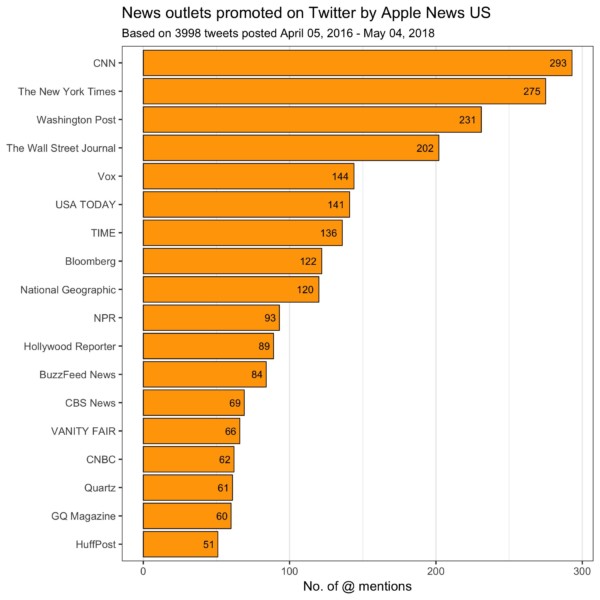
These four accounts, which averaged 250 mentions each, accounted for 28 percent of all mentions made by @AppleNews. The remaining mentions were shared among 319 accounts at an average of eight mentions each.
If the Times is the darling of Apple News UK, then its UK equivalent is the Telegraph, a conservative daily broadsheet.
Apple News has been championed as “a channel that consistently and continuously performs well” for the Telegraph, which also began selling ads in the app in January 2017.
For its part, Apple News UK has consistently and continuously featured the Telegraph in its newsletter and its Twitter recommendations. With 46 article recommendations in 87 newsletters, The Telegraph has received a recommendation more than once every other newsletter on average. Trailing far behind in second was National Geographic, which has featured 28 times.
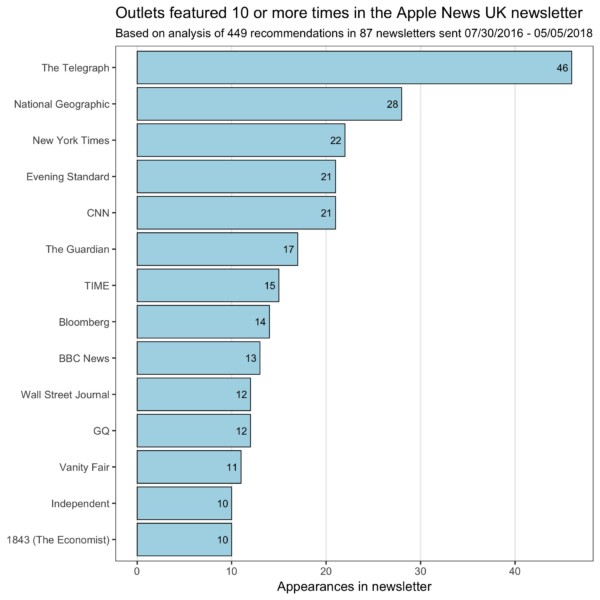
Also notable is the prominence of US outlets in the UK newsletter. Perhaps surprisingly, the New York Times and CNN appeared more frequently than BBC News and The Guardian, for example.
On Twitter, the London Evening Standard is remarkably prominent, receiving 82 mentions—the fifth highest of any publisher mentioned by @AppleNewsUK. However, this account’s mentions are well and truly dominated by two major publishers, The Guardian and the Telegraph, and two major broadcasters, Sky News and BBC News UK.
These four publishers alone were mentioned a total of 1,171 times, an average of 293 each. This equates to 48 percent of all 2,415 mentions made by @AppleNewsUK, suggesting an ever stronger emphasis on a small group of major players than at @AppleNews. The remaining 1,244 mentions were shared among 248 publishers at an average of just five each.

How much space was given to regional publishers?
Only 14 of the 390 US newsletter recommendations were for articles from regionally-focused news outlets, and those were almost exclusively from larger outlets such as New York magazine and the Los Angeles Times.
Articles from these regionally focused publishers accounted for less than 4 percent of US newsletter recommendations. Put another way, articles by regional publishers were recommended approximately once every six weeks.
The picture is similar in the UK. Only one regional publisher was promoted in the UK newsletter, the London-based Evening Standard. Stories from the Standard were featured 21 times, meaning that regional publishers—or more specifically, the Evening Standard—accounted for under 5 percent of all recommendations.
ICYMI: Facebook’s defense is’everyone was doing it’
The promotion of regional publishers is similarly rare on Apple News’s Twitter feeds. In fact, the proportion of Twitter mentions dedicated to regional news outlets is remarkably similar to the proportion of space afforded to them in Apple News’ Spotlight newsletters—under 2 percent of accounts mentioned by @AppleNews were regional publishers. For @AppleNewsUK it was under 3 percent. The Evening Standard accounted for all but one of the 83 mentions of regional UK publishers by @AppleNewsUK. The other was for the Manchester Evening News.
In the US, the Los Angeles Times got the lion’s share from @AppleNews, racking up 39 of the 61 Twitter mentions of regional publishers—approximately two-thirds—with New York-centric outlets New York magazine, the New York Post, and The New Yorker accounting for thirteen of the remaining twenty-two.
So when Apple News gives space to regional publishers, it’s an oddity. And even then, those “original, compelling stories” tend to come from a rather shallow pool.
Has America ever needed a media defender more than now? Help us by joining CJR today.



